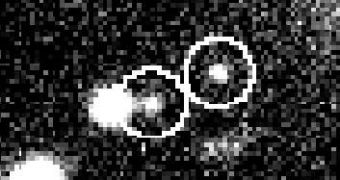The two objects in the Kuiper Belt (the icy ring at the edge of our solar system, 6 billion km away from Earth) share a common name, 2001 QW322. They orbit each other in what appears to be the faintest reciprocal influence of two celestial bodies in our system, and they have been doing so for billions of years, which is when their weird relationship first started. The distance between them was calculated to be of about 100,000 km, and although not as large as that between a planet and its moon(s), or that between the Sun and the planets, it is the largest between 2 small KBOs influencing each other.
Their orbiting speed is also intriguing, since it is very small – about 3 km/h or less than 2 mph (like that of a slow human walk). Their strange bond is due to the fact that, during the formation of the solar system, the large planets cleaned their way by sweeping or scattering their potentially colliding neighbors.
However, at any point, this faint relationship could end violently, although the Kuiper Belt is far less dense in objects now than it was in its earlier ages. One of the discoverers of the strange couple, Jean-Marc Petit from the Bensacon University in France, estimates that this could happen anywhere between 300 million and 1 billion years from now.
The most probable theory for the pair's birth involves a collision of one of its members, which would have slowed it down enough in order to eventually be caught into a reciprocal orbit with the other. The second place for such a long-distance bond is occupied by Haumea and a 50,000 km distant orbiting moon. But this would be natural, since Haumea is about 1,000 times bigger than the 2001 QW322 group and, as such, its gravity is stronger.
The pair is about 3,000 times smaller than Pluto, and approximately 22,500 times smaller than Earth. The distance between the pair's members is larger than a quarter of that between Earth and its moon. Finding more such bonded objects could help experts learn more about the way the Kuiper Belt formed.

 14 DAY TRIAL //
14 DAY TRIAL //